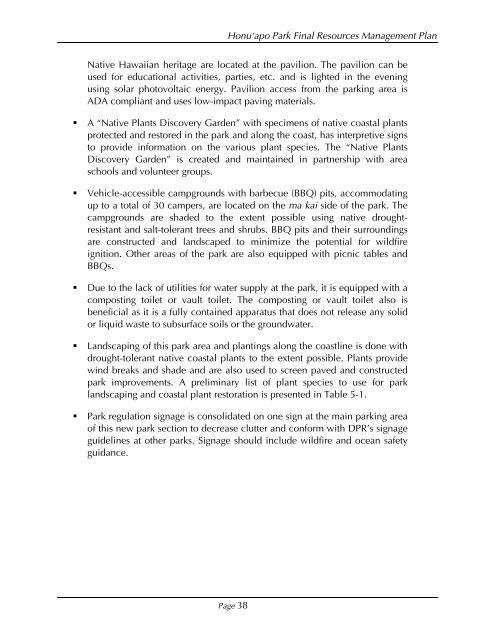Honu'apo Park Resource Management Plan
Honu'apo Park Resource Management Plan
Honu'apo Park Resource Management Plan
You also want an ePaper? Increase the reach of your titles
YUMPU automatically turns print PDFs into web optimized ePapers that Google loves.
Honuÿapo <strong>Park</strong> Final <strong>Resource</strong>s <strong>Management</strong> <strong>Plan</strong><br />
Native Hawaiian heritage are located at the pavilion. The pavilion can be<br />
used for educational activities, parties, etc. and is lighted in the evening<br />
using solar photovoltaic energy. Pavilion access from the parking area is<br />
ADA compliant and uses low-impact paving materials.<br />
� A “Native <strong>Plan</strong>ts Discovery Garden” with specimens of native coastal plants<br />
protected and restored in the park and along the coast, has interpretive signs<br />
to provide information on the various plant species. The “Native <strong>Plan</strong>ts<br />
Discovery Garden” is created and maintained in partnership with area<br />
schools and volunteer groups.<br />
� Vehicle-accessible campgrounds with barbecue (BBQ) pits, accommodating<br />
up to a total of 30 campers, are located on the ma kai side of the park. The<br />
campgrounds are shaded to the extent possible using native droughtresistant<br />
and salt-tolerant trees and shrubs. BBQ pits and their surroundings<br />
are constructed and landscaped to minimize the potential for wildfire<br />
ignition. Other areas of the park are also equipped with picnic tables and<br />
BBQs.<br />
� Due to the lack of utilities for water supply at the park, it is equipped with a<br />
composting toilet or vault toilet. The composting or vault toilet also is<br />
beneficial as it is a fully contained apparatus that does not release any solid<br />
or liquid waste to subsurface soils or the groundwater.<br />
� Landscaping of this park area and plantings along the coastline is done with<br />
drought-tolerant native coastal plants to the extent possible. <strong>Plan</strong>ts provide<br />
wind breaks and shade and are also used to screen paved and constructed<br />
park improvements. A preliminary list of plant species to use for park<br />
landscaping and coastal plant restoration is presented in Table 5-1.<br />
� <strong>Park</strong> regulation signage is consolidated on one sign at the main parking area<br />
of this new park section to decrease clutter and conform with DPR’s signage<br />
guidelines at other parks. Signage should include wildfire and ocean safety<br />
guidance.<br />
Page 38


